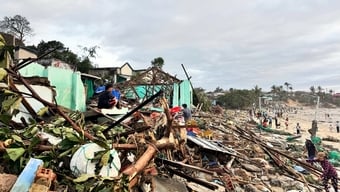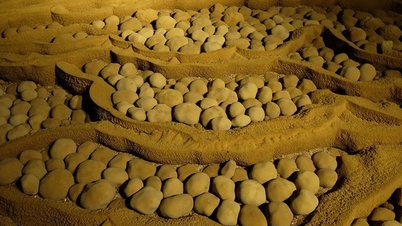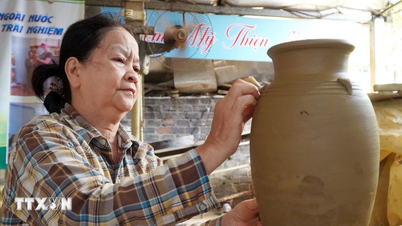Vertebral collapse comes from many causes, but the most common is degeneration. The disease can happen to anyone, but mainly the elderly. Vertebral collapse needs to be treated as soon as possible to avoid causing pain, dangerous complications, and affecting the patient's mobility.
Osteoporosis, also known as porous bone, is characterized by a decrease in bone structure due to a decrease in bone mass and deterioration of bone structure. Bone strength is the result of a delicate balance between two types of bone cells: osteoblasts – which harden bone and osteoclasts – which break down bone (responsible for bone resorption) and when osteoclasts are more active than osteoblasts, they weaken the bone.
Causes of osteoporosis
Age is the leading cause of decreased bone density. In addition, some of the following factors can also cause the disease: Women entering menopause or having irregular menstrual cycles causing decreased estrogen levels are often at high risk of the disease. In men, low testosterone levels are also a cause of osteoporosis.
Unscientific diet, lacking nutrients, especially substances beneficial for bones and joints such as calcium, vitamin D, omega-3... not providing enough calcium needed during the formation and development of the skeletal system is also the cause of early bone and joint weakness.
Side effects of drugs due to long-term use of corticosteroids and heparin without following doctor's instructions.
A sedentary lifestyle, lack of exercise , low activity levels, sitting a lot… can all lead to weakened bones and joints.
Stimulants such as alcohol, beer, and cigarettes are harmful agents that promote and weaken the skeletal system.
Heavy laborers who have to regularly carry heavy objects are at higher risk of musculoskeletal diseases than normal people.

Osteoporosis is often asymptomatic until a fracture occurs.
Symptoms of osteoporosis
Osteoporosis is often asymptomatic until a fracture occurs. Patients with acute vertebral compression fractures may experience sudden onset of back pain when sneezing, coughing, lifting heavy objects, or changing position. Other clinical manifestations include: Height loss due to vertebral compression fractures. May be diagnosed incidentally (most osteoporosis-related vertebral compression fractures are diagnosed in patients undergoing X-rays for other reasons).
Symptoms of vertebral collapse due to osteoporosis
Osteoporosis often develops silently over many years and fractures are often the first warning signs. The elderly or patients with osteoporosis need to be alert to the symptoms of vertebral collapse, to avoid missing and causing serious consequences. Vertebral collapse due to osteoporosis can cause the following symptoms and sequelae:
- Severe back pain corresponding to the position of the collapsed vertebrae after minor trauma (falling from sitting, twisting...) or even appearing spontaneously.
- Limited mobility: Some patients cannot sit up, cannot walk, or have great difficulty moving due to back pain.
- If left untreated or treated improperly for more than 2 months, the disease can progress to a chronic pain stage, causing constant aching and severely affecting motor function.
- Functional urinary and bowel dysfunction: Often the cause of the disorder is due to the patient being in too much pain, lying still for a long time, or being embarrassed or afraid to go to the toilet while lying down.
- In cases of spinal collapse causing hunchback and spinal cord compression, many patients may experience paralysis of both legs and physical urinary and bowel dysfunction.
- Later on, the patient may experience serious spinal deformities (e.g., loss of height, scoliosis, hunchback, hunched back, etc.)
- Chronic rib pain due to ribs pressing against the pelvis in severe kyphosis.
- Loss of ability to care for oneself or perform normal daily activities.
- Reduced lung capacity, leading to chronic shortness of breath.
- Loss of appetite, anxiety, depression, insomnia…
Medical advice
Depending on the degree of spinal collapse and any associated nerve damage (if any), appropriate treatment methods will be used. Usually, patients will be treated medically.
Treatment methods: Percutaneous vertebral body reconstruction with biological cement injection is used for cases of vertebral collapse due to osteoporosis without nerve damage, the degree of vertebral collapse
Summary : Vertebral collapse or vertebral collapse is a condition in which the vertebral body cannot maintain its original height, causing damage to the spine and severe pain for the patient. Vertebral collapse is related to age and seriously affects health. The disease can increase the risk of vertebral fractures, affecting mobility and even the patient's life expectancy. Therefore, for the elderly, especially postmenopausal women, it is necessary to develop a suitable diet and exercise regularly. At the same time, supplement minerals rich in vitamin D, calcium and other vitamins. Eat a balanced diet with adequate nutrients. Regularly have periodic health check-ups or as prescribed by your doctor to detect osteoporosis or spinal diseases for timely treatment.
Dr. Nguyen Minh Duong
Source: https://giadinh.suckhoedoisong.vn/trieu-chung-cua-xep-dot-song-do-loang-xuong-172241121113623506.htm


![[Photo] Da Nang: Hundreds of people join hands to clean up a vital tourist route after storm No. 13](https://vphoto.vietnam.vn/thumb/1200x675/vietnam/resource/IMAGE/2025/11/07/1762491638903_image-3-1353-jpg.webp)





































































































Comment (0)